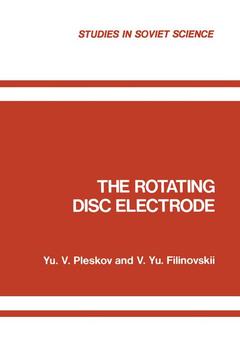Description
The Rotating Disc Electrode, Softcover reprint of the original 1st ed. 1976
1976 Series
Author: Pleskov Yu. V.
Language: English
Subject for The Rotating Disc Electrode:
Approximative price 52.74 €
In Print (Delivery period: 15 days).
Add to cart
Publication date: 04-2012
402 p. · 15.2x22.9 cm · Paperback
402 p. · 15.2x22.9 cm · Paperback
Description
/li>Contents
/li>
Important advances in a subject are as often promoted by a new technique as by new concepts and theories. In the study of electrode reactions which involve diffusion in a primary or a secondary step, the development and use of techniques involving rotating disc electrodes and derived instrumentation based on ring-disc and split-ring systems has enabled advances of great importance to be made in the quantitative examination of diffusion processes at electrodes and their role in electrode processes generally. The technique allows precisely defined mass-transport conditions to be set up which can be subjected to exact mathe matical analysis so that quantitative treatment of hydrodynamic and diffusion behavior can be made. Of special interest for elec trochemists is the opportunity which the rotating ring-disc system offers for studying solution-soluble intermediates in sequential electrode processes and the kinetics of their reactions in solution. In this book by Pleskov and Filinovskii, both the experimental techniques and the mathematical analysis for the treatments of results for various conditions and types of reaction are described in detail. We believe that presentation of work that has been car ried out by means of rotating electrode techniques, to a large extent by Russian workers, in the form of a concise book will be of great value both to electrochemists and kineticists, and those interested in the physics of fluid motion.
1 Liquid Flow at a Rotating Disc.- §1.1. Basic Equations of Flow of a Viscous Incompressible Liquid.- §1.2. Solution of Equation of Motion for a Viscous, Incompressible Liquid at the Surface of a Rotating Disc.- §1.3. “Similarity” of Hydrodynamic Phenomena.- §1.4. Turbulent Flow.- References.- 2 Convective Diffusion.- §2.1. Basic Equations of Convective Diffusion in a Moving Liquid.- §2.2. Theory of “Similarity” of Mass-Transport Processes.- §2.3. Solution of the Equation of Convective Diffusion to the Surface of a Rotating Disc.- §2.4. Diffusional Flux.- §2.5. Quantitative Verification of the Theory; Laminar Flow.- §2.6. Measurements of Diffusion Coefficients.- §2.7. Concentration Measurements. Analytical Applications of the Rotating Disc Electrode.- §2.8. Approximate Calculation Methods for Convective Diffusion.- §2.9. Diffusion Flux under Turbulent Conditions.- References.- 3 Mixed Kinetics of Heterogeneous Reactions.- §3.1. The Rate of the Heterogeneous Reaction.- §3.2. Basic Equation of Mixed Kinetics.- §3.3. Determination of the Reaction Order and of the Rate Constant.- §3.4. First-Order Reactions.- §3.5. Experimental Determination of the Kinetic Characteristics of an Electrode Reaction.- §3.6. The State of the Electrode Surface and the Transition from Diffusion to Mixed Kinetic Control.- §3.7. Mixed Kinetics of Heterogeneous Reactions at the Surface of a Nonuniform Disc.- References.- 4 Electric Current in a Cell with a Rotating Disc Electrode.- §4.1. General Equations.- §4.2. Electric Current Flow in the Cell.- §4.3. Distribution of the Electric Field and of Ionic Concentrations in the Vicinity of the Electrode.- §4.4. Distribution of the Electric Field and of Ionic Concentrations in the Double-Layer Region.- §4.5. Voltammetric Curves.- §4.6. The Limiting Current.- §4.7. The Rotating Disc Electrode in Solutions of a Binary Electrolyte.- §4.8. The Rotating Disc Electrode in a Solution Containing an Excess of Inert Electrolyte 154.- §4.9. Voltammetric Characteristics of the Cell in the Case of a Redox Reaction.- §4.10. The Ohmic Potential Drop in the Cell.- References.- 5 Nonstationary Processes at the Rotating Disc Electrode.- §5.1. General Comments on Nonstationary Diffusion.- §5.2. Equations for Nonstationary Convective Diffusion.- §5.3. Establishment of a Stationary Regime for the Given Surface Concentration of the Transferred Species.- §5.4. Establishment of a Stationary Regime at a Given Density of Diffiisional Flux (Relaxation of Potential upon Switching on Constant Current). 182 §5.5. Establishment of a Stationary Current for an Irreversible Electrode Reaction.- §5.6. Polarization of the Electrode with Potentials Varying in Time: General Equations.- §5.7. Polarization of the Electrode with a Linear Potential Sweep. The Case of a Reversible.- Reaction.- §5.8. Polarization of an Electrode with a Periodically Oscillating Potential.- §5.9. Autooscillating Processes.- References.- 6 Studies of Chemical Reactions in a Bulk Phase (Kinetic and Catalytic Currents).- §6.1. General Method of Calculation of Kinetic Currents at the Rotating Disc Electrode.- §6.2. Preceding Chemical Reaction.- §6.3. Catalytic Processes.- §6.4. The Effect of Chemical Reactions Following the Electrochemical Processes.- §6.5. Investigation of Chemical Reactions of Electrochemically Inactive Species.- References.- 7 Application of the Rotating Disc Electrode to Various Electrochemical Problems.- §7.1. Separation of Two Simultaneous Electrode Processes.- §7.2. Study of the Type of Polarization in Metal Deposition.- §7.3. Anodic Metal Dissolution and Electropolishing.- §7.4. Corrosion of Metals. Dissolution of Nonmetals.- §7.5. The Rotating Disc in Systems with Variable Physical Properties.- §7.6. Thermal Diffusion near the Surface of a Rotating Disc.- References.- 8 Rotating Ring-Disc Electrode.- §8.1. Calculation of the Current at the Ring Electrode.- §8.2. Quantitative Verification of the Theory.- §8.3. Application of the Rotating Ring-Disc Electrode to Mechanistic and Kinetic Studies of Multistep Electrode Reactions (Theory).- §8.4. Experimental Studies of Oxygen Reduction.- §8.5. Determination of Reaction Orders of Separate Stages of an Electrochemical Process.- §8.6. Voltammetric Curve at the Ring.- §8.7. Kinetic Currents and Nonstationary Processes.- §8.8. Application of the Ring-Disc Assembly to Studies of Anodic Dissolution, Corrosion and Passivation of Metals, and Electrode Reactions Involving Organic and Inorganic Compounds.- References.- 9 Design of the Rotating Disc Assembly.- §9.1. The Disc Electrode.- §9.2. Drive Mechanism; Measurements of Rotation Speed.- §9.3. Electrochemical Cell.- References.- Appendix 1. Articles on the Rotating Disc Electrode.- Appendix 2. Supplementary References.
© 2024 LAVOISIER S.A.S.




